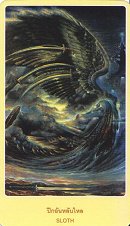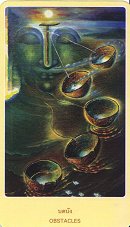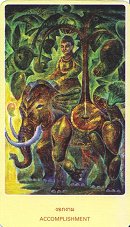|
Tarot Reflections |
|
January 1, 2004 |
|
Deck Review: Roots of Asia Tarot Marisa Antonaya |
||||
|
|
I have lived in Thailand for almost three years, and in that time I've come to know a bit about Buddhism as it is practiced here, and what makes it unique in Asia. Thai Buddhism follows the Theravada path (as opposed to Mahayana, practiced in China and other countries), but it has become mixed with the animist traditions that existed before. This has resulted an eclectic group of beliefs and practices, among which we find divination. Divination is not part of Buddhism itself, but related to the local beliefs. However, it is often practiced in the temples, which gives the impression that it is somehow related to Buddhism; to the Thais, though, it is separate from Buddhist beliefs, although its practice is accepted in the temples. The most popular forms of divination are palm reading and astrological/numerological charts based on the Buddhist lunar calendar. Other methods include numbered bamboo sticks that are shaken until one falls out, and answer basic questions on health, love, etc.; and two-sided stones that are tossed for "yes/no" questions. Tarot, however, is virtually unknown, although some people do use playing cards in divination. Knowing this, I was intrigued when I ran across the Roots of Asia tarot deck. I had briefly seen an article on the artist, Amnaj Grunpracha, in one of the English-language newspapers, but I did not pay much attention at the time. A few months later, I saw the deck at, of all places, my local 7-11 store! It was at the checkout counter, proudly displayed next to the chewing gum and chocolate bars, and I didn't give it a second thought. It came home with me, and I spent the next few hours translating the card titles and their correspondences with a Thai friend. My deck has both Thai and English titles on the cards, but the book is only in Thai. However, the deck has apparently been translated into several languages, and there is an all-English edition out. Before going into the details, it's important to point out that this is, indeed, a Tarot deck...and yet there's a lot about it that's not quite Tarot. The structure is Tarot, the suits are Tarot, but some of the meanings will feel "odd" to many readers. On the other hand, many other correspondences will give readers another level of meaning to work with; in addition to the traditional one they may have learned. This means that Roots of Asia is, in my opinion, most rewarding for more advanced readers; I think that novice readers might feel confused, especially if they compare the Roots of Asia cards to those in their more standard decks. The deck's creator, Amnaj Grunpracha, is an artist currently teaching at one of the major universities in Bangkok. According to the book that comes with the deck, he has spent the past 30 years dedicated to translating his understanding of Buddhist philosophy through the arts, and his paintings have been exhibited in various countries. The Roots of Asia deck is one part of the artist's journey, and took four years to complete. With the deck, he hopes to make the Thripidok (the Buddhist "Bible") available to those looking for the meaning of life. More than a simple divination system, Amnaj Grunpracha sees Roots of Asia as a blend of Tarot, Buddhist Dhamma (teachings), folk beliefs, and logical reasoning that can contribute to everyday problem-solving but also to a deeper search. The deck does, indeed, feel "deep". Nevertheless, true to the essential simplicity of Buddhist teachings, it's not heavily packed with symbolism (the way a deck like Crowley's Thoth is). Rather, each card has a meaningful title and an image the complements the teaching expressed by this word. The titles correspond to the body of teachings (dhamma) associated with Buddhism; it helps to be somewhat acquainted with these concepts, since it will make the interpretations a lot more meaningful, but for more intuitive readers, I think the images speak quite nicely. As I mentioned earlier, there is a learning curve for this deck, partly because it presents a specific philosophy, but also because the traditional card titles have been completely replaced, and the cards are not numbered. Also, the correspondences to traditional Tarot cards aren't always obvious. Some of the more baffling title correspondences actually tend to work out with a bit of thought, while others never seem to find a meeting point with the card's "standard" meaning. For example, the 4 of Swords is given the keyword "Sloth", which is not a concept I'd ever associate to this card. Indeed, an excessive period of rest and recovery can turn into sloth if one doesn't get back into their path, but it's still not the first impression when I think of a 4 of Swords energy. Other times, the corresponding keywords work beautifully, in my opinion. The Fool is called "Purity of Mind", and the Moon is titled "Patience." Interpreting these cards is really a matter of being able to connect with the images and the teachings attached to each card. The images themselves, though, are so hypnotically beautiful that it's easy to let the mind go and feel around for the meaning. The artwork reminds me of the Haindl Tarot deck; but while Haindl's deck tends to express itself in "earthy" colors, Roots of Asia works more with deep blues and greens, which give it a more "cosmic" feel. The suits are Wands, Swords, Cups, and Discs, but these objects come from traditional Thai symbols and utensils. The cups are coconut shells (often used for drinking water of gathering liquid in the countryside), and the wands are stalks tipped with lotus flowers. The local fauna is also represented: elephants appear in most Disc cards, and tigers are present in many Wands cards. So is Roots of Asia a reading deck? Well, I think it really depends on how one approaches it. It's certainly a great meditation deck, especially for students of Buddhist teachings, and this practice could lead to reading with the cards. There are some aspects that make it a difficult deck for readers who closely follow standard Tarot meanings. Cards are not numbered, and all the traditional names for the cards have been replaced by the concept-titles. In the Minor suits, it's sometimes hard to count the number of swords, wands, etc. in the images; and since the cards have no numbers, this could be a distraction or obstacle for some people. I haven't done any readings with this deck yet, so I can't really judge this aspect, but the feeling I get is that a reader wanting to use these cards in divination would need to be very open-minded and flexible to work successfully with the Roots of Asia deck. But then, openness and flexibility are at the heart of the Buddhist philosophy, and this is precisely the deck's challenge to the seeker: to forget what we have learned in the past, and concentrate on the image before us now.
| |||
|
Subscribe to Tarot Reflections, and receive notification of each update! |
|
Request to be added to the list by sending email to TarotReflections-subscribe@yahoogroups.com! |
All articles remain the
property of their respective authors.
Tarot Reflections is a publication of the American Tarot Association
- Copyright (C) 2004
Questions or Comments? Contact Us.





